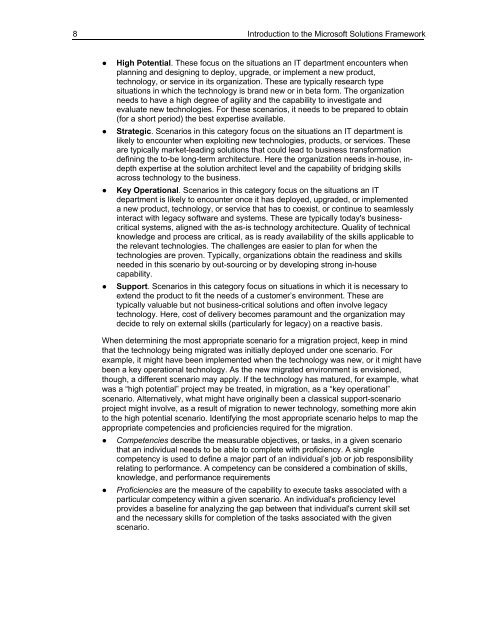Solution Guide for Migrating Oracle on UNIX to SQL Server - Willy .Net
Solution Guide for Migrating Oracle on UNIX to SQL Server - Willy .Net
Solution Guide for Migrating Oracle on UNIX to SQL Server - Willy .Net
- No tags were found...
Create successful ePaper yourself
Turn your PDF publications into a flip-book with our unique Google optimized e-Paper software.
8Introducti<strong>on</strong> <strong>to</strong> the Microsoft <str<strong>on</strong>g>Soluti<strong>on</strong></str<strong>on</strong>g>s Framework●●●●High Potential. These focus <strong>on</strong> the situati<strong>on</strong>s an IT department encounters whenplanning and designing <strong>to</strong> deploy, upgrade, or implement a new product,technology, or service in its organizati<strong>on</strong>. These are typically research typesituati<strong>on</strong>s in which the technology is brand new or in beta <str<strong>on</strong>g>for</str<strong>on</strong>g>m. The organizati<strong>on</strong>needs <strong>to</strong> have a high degree of agility and the capability <strong>to</strong> investigate andevaluate new technologies. For these scenarios, it needs <strong>to</strong> be prepared <strong>to</strong> obtain(<str<strong>on</strong>g>for</str<strong>on</strong>g> a short period) the best expertise available.Strategic. Scenarios in this category focus <strong>on</strong> the situati<strong>on</strong>s an IT department islikely <strong>to</strong> encounter when exploiting new technologies, products, or services. Theseare typically market-leading soluti<strong>on</strong>s that could lead <strong>to</strong> business trans<str<strong>on</strong>g>for</str<strong>on</strong>g>mati<strong>on</strong>defining the <strong>to</strong>-be l<strong>on</strong>g-term architecture. Here the organizati<strong>on</strong> needs in-house, indepthexpertise at the soluti<strong>on</strong> architect level and the capability of bridging skillsacross technology <strong>to</strong> the business.Key Operati<strong>on</strong>al. Scenarios in this category focus <strong>on</strong> the situati<strong>on</strong>s an ITdepartment is likely <strong>to</strong> encounter <strong>on</strong>ce it has deployed, upgraded, or implementeda new product, technology, or service that has <strong>to</strong> coexist, or c<strong>on</strong>tinue <strong>to</strong> seamlesslyinteract with legacy software and systems. These are typically <strong>to</strong>day's businesscriticalsystems, aligned with the as-is technology architecture. Quality of technicalknowledge and process are critical, as is ready availability of the skills applicable <strong>to</strong>the relevant technologies. The challenges are easier <strong>to</strong> plan <str<strong>on</strong>g>for</str<strong>on</strong>g> when thetechnologies are proven. Typically, organizati<strong>on</strong>s obtain the readiness and skillsneeded in this scenario by out-sourcing or by developing str<strong>on</strong>g in-housecapability.Support. Scenarios in this category focus <strong>on</strong> situati<strong>on</strong>s in which it is necessary <strong>to</strong>extend the product <strong>to</strong> fit the needs of a cus<strong>to</strong>mer’s envir<strong>on</strong>ment. These aretypically valuable but not business-critical soluti<strong>on</strong>s and often involve legacytechnology. Here, cost of delivery becomes paramount and the organizati<strong>on</strong> maydecide <strong>to</strong> rely <strong>on</strong> external skills (particularly <str<strong>on</strong>g>for</str<strong>on</strong>g> legacy) <strong>on</strong> a reactive basis.When determining the most appropriate scenario <str<strong>on</strong>g>for</str<strong>on</strong>g> a migrati<strong>on</strong> project, keep in mindthat the technology being migrated was initially deployed under <strong>on</strong>e scenario. Forexample, it might have been implemented when the technology was new, or it might havebeen a key operati<strong>on</strong>al technology. As the new migrated envir<strong>on</strong>ment is envisi<strong>on</strong>ed,though, a different scenario may apply. If the technology has matured, <str<strong>on</strong>g>for</str<strong>on</strong>g> example, whatwas a “high potential” project may be treated, in migrati<strong>on</strong>, as a “key operati<strong>on</strong>al”scenario. Alternatively, what might have originally been a classical support-scenarioproject might involve, as a result of migrati<strong>on</strong> <strong>to</strong> newer technology, something more akin<strong>to</strong> the high potential scenario. Identifying the most appropriate scenario helps <strong>to</strong> map theappropriate competencies and proficiencies required <str<strong>on</strong>g>for</str<strong>on</strong>g> the migrati<strong>on</strong>.● Competencies describe the measurable objectives, or tasks, in a given scenariothat an individual needs <strong>to</strong> be able <strong>to</strong> complete with proficiency. A singlecompetency is used <strong>to</strong> define a major part of an individual’s job or job resp<strong>on</strong>sibilityrelating <strong>to</strong> per<str<strong>on</strong>g>for</str<strong>on</strong>g>mance. A competency can be c<strong>on</strong>sidered a combinati<strong>on</strong> of skills,knowledge, and per<str<strong>on</strong>g>for</str<strong>on</strong>g>mance requirements● Proficiencies are the measure of the capability <strong>to</strong> execute tasks associated with aparticular competency within a given scenario. An individual's proficiency levelprovides a baseline <str<strong>on</strong>g>for</str<strong>on</strong>g> analyzing the gap between that individual's current skill setand the necessary skills <str<strong>on</strong>g>for</str<strong>on</strong>g> completi<strong>on</strong> of the tasks associated with the givenscenario.
















